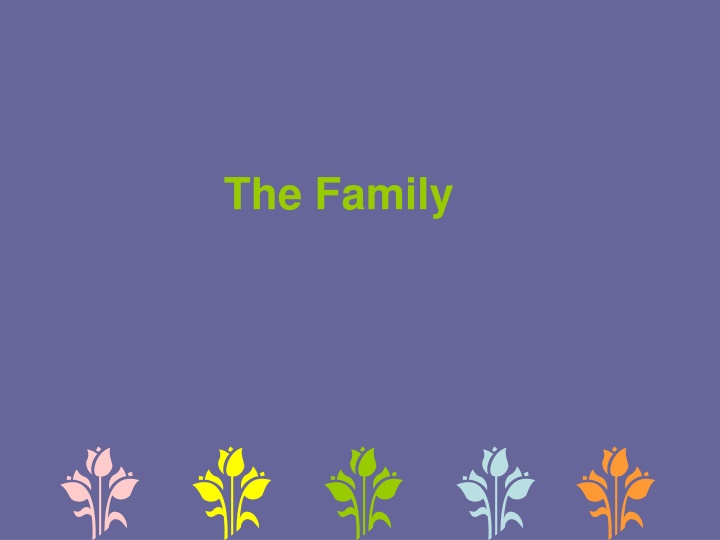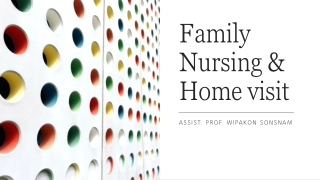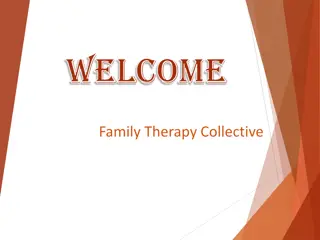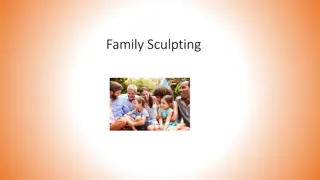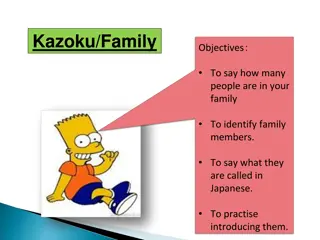The Family
Families come in various structures and play a crucial role in society. From traditional nuclear families to multigenerational setups, each family has its unique characteristics and functions. Family health involves not just the physical well-being of its members but also how they interact within and outside the family unit. Explore the complexities of family relationships, roles, and interactions to grasp the essence of familial bonds.
Download Presentation

Please find below an Image/Link to download the presentation.
The content on the website is provided AS IS for your information and personal use only. It may not be sold, licensed, or shared on other websites without obtaining consent from the author.If you encounter any issues during the download, it is possible that the publisher has removed the file from their server.
You are allowed to download the files provided on this website for personal or commercial use, subject to the condition that they are used lawfully. All files are the property of their respective owners.
The content on the website is provided AS IS for your information and personal use only. It may not be sold, licensed, or shared on other websites without obtaining consent from the author.
E N D
Presentation Transcript
Family Definition theorists suggest that a family consists of two or more individuals who share a residence or live near one another; have some common emotional bond; engage in interrelated social positions, roles, and tasks; and share cultural ties and sense of love and belonging
Family health is concerned with how well the family functions together as a unit. It involves not only the health of the members and how they relate to other members, but also how well they relate to and cope with the community outside the family.
Characteristics of Families It provides an important key to understanding each family's uniqueness. Every family is a small social system. Every family has its own cultural values and rules. Every family has structure. Every family has certain basic functions. Every family moves through stages in its life cycle.
Family Structures Family structures fall into two general categories: traditional and modern. Traditional family structures are those that are most familiar to us. They include the nuclear family husband, wife, and children living together in the same household.
In nuclear families, the workload distribution between the two adults can vary. Both adults may work outside the home; one adult may work outside the home while the other stays at home and assumes primary responsibilities for the household
A nuclear-dyad family consists of a husband and wife living together who have no children or who have grown children living outside the home. single-adult families, in which one adult is living alone by choice or because of separation from a spouse or children or both. Separation may be the result of divorce,
Multigenerational families, in which several generations or age groups live together in the same household. A household in which a widowed woman lives with her divorced daughter and two young grandchildren is an example of a multigenerational family, as is one in which adult children live with aging parents.
a kin-network, in which several nuclear families live in the same household or near one another and share goods and services. They may own and operate a family business, sharing work and child care responsibilities.
modern Families Society has begun to accept nontraditional definitions of family. The concept of wider family . is defined as a family that emerges from lifestyle, is voluntary, and independent of necessary biological or kin connections With today's wide variety of family types and structures.
A group-marriage family involves several adults who share a common household and consider that all are married to one another; they share child rearing. A group-network family is made up of unrelated nuclear families that are bound by a common set of values, such as a religious system. These families live close to one another and share goods, services.
Homeless families are increasing in numbers, and their characteristics are changing. In 2005, about 41% of the counted homeless population were families with children.
Facts about Families in America On any given night in the United States, there are 500,000 to 600,000 homeless men, women, and children Some 500,000 children go missing each year. More than 3 million children live with their grandparents as the primary care providers. Approximately 500,000 children are in foster homes.
Almost 8% of girls between 15 and 19 years of age get pregnant each year, producing 750,000 pregnancies annually. Ten percent of the population has significant problems related to substance abuse . At least 4% of U.S. households include three generations; approximately 78,000 homes include four generations . In California, gay adoptions, or second-parent adoptions, number 10,000 .
Facts about Families in Jordan Large families are traditionally desired, but family sizes are declining due to economic necessity. To be able to help another member of the family is considered an honor as well as a duty. Parents will often help or support their children even after marriage.
The father is considered head of the family and is expected to provide for the family financially. The mother is expected to take care of the children and household.
Family Functions families have produced children, physically maintained their members, protected their health, encouraged their education or training, given emotional support and acceptance, and provided supportive and promotion care during illness.
Providing Affection The family functions to give members affection and emotional support. love brings couples together. In some other cultures, affection comes after marriage. Continued affection creates an atmosphere of care for all family members,
Providing Security and Acceptance create a secure environment. Members need to know that these basics will be available and that the family is committed to providing them. The stability of the family unit also gives members a sense of security.
Instilling Identity and Satisfaction Positive reflections provide the individual with a sense of satisfaction and worth such as that experienced by a girl when her family applauds her efforts in a swim meet or by a boy whose family praises the bird house he builds. Needs fulfillment in the home determines satisfaction in the outside world;
Promoting relationship and friendship The family functions to give members a sense of belonging throughout life. Because families provide associational bonds and group membership, they help satisfy their members' needs for belonging.
Providing Socialization The family functions to socialize the young. Families transmit their culture their values, attitudes, goals, and behavior patterns to their members. Members, socialized into a way of life that reflects and preserves the family's cultural.
Establishing Controls The family functions to maintain social control. Families maintain order through establishment of social controls both within the family and between family members and outsiders.
Stages of the Family Life Cycle There are two stages: 1- expansion as new members are added and roles and relationships are increased. 2- contraction as family members leave to start lives of their own or age and die.
Stages of the Family Life Cycle Forming a partnership Childbearing Pre-school age School-age Teenage Launching center Middle age parents Aging family members
The nurse Roles in Promoting Family Health Apply the nursing process in the care of families Build personal knowledge base about family structures, functions and developmental tasks Work with families to improve family functioning
